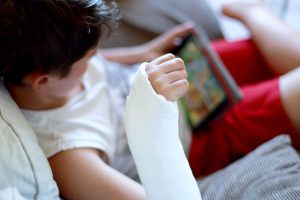 If you’re a parent, you know that accidents happen! Your child comes home from the ball field or the ice-skating rink and says something hurts. There are some things you can see for yourself that help you figure out what’s going on. It is important to recognize whether your child could be dealing with a broken bone so that you can bring them in to see the pediatrician right away.
If you’re a parent, you know that accidents happen! Your child comes home from the ball field or the ice-skating rink and says something hurts. There are some things you can see for yourself that help you figure out what’s going on. It is important to recognize whether your child could be dealing with a broken bone so that you can bring them in to see the pediatrician right away.
Here are signs to look for if you suspect your child’s bone is broken:
- The limb is painful, or your child says it hurts.
- The area is swollen, bruised or looks deformed.
- Your child can’t move the limb, put weight on it or pick anything up.
- There is swelling.
- There was a popping or snapping sound at the moment of impact or injury.
If a broken bone pierces the skin, it’s called a compound fracture. If this happens, you will want to call 911. Your child will need surgery to realign the bones and then a cast to keep it immobilized.
The Most Common Bones Kids Fracture
Arms and lower legs are the most frequently injured parts of children’s bodies. The elbows, ankles, and wrist are the most commonly treated injuries. The most common causes of bone fractures in young people are monkey bars, trampolines, scooters, snowboarding, and general sports. The bone fracture ratio is about 59% boys and 41% girls.
What Is The Treatment For A Broken Bone?
Your pediatrician will order X-rays to determine the location and severity of the break. Most fractures heal well and cause no long-term complications. Fractures are usually treated by using a splint or a cast (full or partial) to restrict movement until the bone heals. Looking after the cast is important to ensure your child’s bone heals correctly and to prevent damage to their skin.
Exercises After A Fracture
Your pediatrician may recommend certain exercises at home every day to help with pain, limited mobility, and swelling. Depending on the type and extent of the injury, a pediatric orthopedist or physical therapist may be referred for your child.
The Healing Process
Kids’ bones are softer than those of grown-ups, so they often heal in less time than it takes adults. Young children often have a speedier recovery than teens. You can expect your child to have a cast for about 4-8 weeks, although it’s sometimes as short as 3 weeks. Even after your child’s cast is removed, their bone will keep healing. At first, it will have a thick layer of new bone surrounding the area. You will be taking your child back to the pediatrician to be checked every few weeks until the bone is healed.
Contact Us (859-525-8181) if you have any questions!
—
 About Pediatrics of Florence
About Pediatrics of Florence
We believe that children are more than just “little adults.” They have unique personalities, challenges, and life circumstances and we have made every effort to make our offices and care as “kid friendly” as possible. We have an aquatic theme in the waiting rooms (separated for sick and well children) as well as themed examination rooms. All of our physicians are Board Certified Pediatricians and members of the American Academy of Pediatrics and our nurse practitioners are all licensed Pediatric Nurse Practitioners and are available to see both well and sick children.
>> Learn More About Pediatrics of Florence
